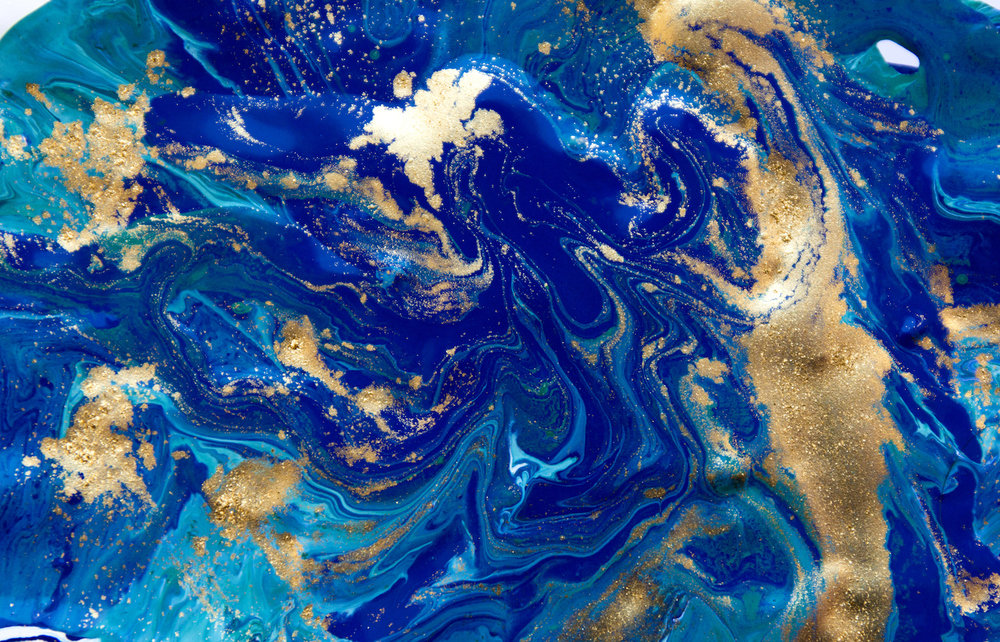Paint Pouring Tips and Tricks

Pouring Acrylic Paint Like a Pro

Contemporary paintings often showcase a wide variety of special effects — especially when the imagery is abstract. Think Jackson Pollock, Morris Louis, and Helen Frankenthaler. Many of those effects can be achieved by pouring acrylic paint.
Pouring is a great way to smooth out unwanted texture, get marbleized effects, rich colored glazes and add some fun to your painting process. Although pouring is a relatively simple technique, it is not always easy.
There are two categories for pouring acrylic paint: coated pours and wash pours. Each requires a different process and will produce different effects.
The following helpful tips and tricks for pouring acrylic paint can help you navigate around the most common pouring problems, starting with a great demo on intuitive pours to get you in the spirit of this free-flowing process.
Tips for Coated Pours
A coated pour can resemble oil paint. It will intensify colors because glossy binders reflect light.
Coated pours generally use a combination of acrylic paint and medium, with little to no water added. The paint creates a fluid shape or layer that sits upon the painting surface, as in Jackson Pollack’s layered drips and high-gloss finishes.
- For best results, use a pouring medium and keep any water additions to less than 40%.
- Pouring mediums come in both thin and thick viscosities. Each will produce different effects. To determine quantities, a good rule of thumb is to plan on about 2 ounces of thin pouring medium to cover an 8” x 10” (20cm x 20cm) surface, and three ounces for thicker pouring mediums.
- Avoid haphazardly adding water to thin pouring mediums. Try using the medium on its own first to determine whether adding water is necessary.
- Allow any excess medium to spill over the sides of the painting surface by propping up the surface with containers or blocks at all four corners.
- Use a leveling device to ensure the pour will remain level while drying.
- Use a rigid substrate to prevent buckling while pouring acrylic paint. If using stretched canvas, be sure to prop up the center to keep it from sinking.
- Before pouring, apply a stain sealer, then prime with gesso. This will prevent stains from coming through the surface into the poured layer.

Tips for Wash Pours
A wash pour can resemble watercolor and will mute colors because it uses heavy amounts of water to dilute the acrylic. This encourages the paint to sink into the painting surface, as in Helen Frankenthaler’s stained canvas effects.
- For best results, do no use any mediums.
- Heavily dilute the paint with water, at least a 1-1 ratio.
- Consider the effect the surface absorbency will have on the result. A wash pour on a glossy surface will break apart into interesting shapes variegations. A wash pour on matte and absorbent surfaces, such as watercolor paper, will soak into the surface to produce an even colored stain.
- Change the surface absorbency by adding acrylic paste or gel before you begin pouring acrylic paint.
- Try to minimize handling of the piece. Instead, let the paint and water move around on their own while drying. The most interesting effects with wash pours often come out of happy accidents.
- Fluid acrylics will offer more intensity of color in wash pours than heavy body acrylics will.
- You can also substitute acrylic inks, high-flow acrylics and airbrush colors in most wash pour techniques for alternate effects.

Intuitive Pours
Want more poured painting tips to try? Check out this preview trailer of Intuitive Art: Poured Paintings with Betsy Dillard Stroud to see some fun pouring in action and for a few ways to bring the poured painting together with glazing and patterns.
“It’s messy, but it’s fun and it teaches you a lot about creating design, color diffusions and just how to let go and have a blast,” notes Stroud in the video. Enjoy!
Ready to watch the full-length instructional video and put your pouring skills to work? Start streaming Intuitive Art: Poured Paintings now.





Have a technical question?
Contact UsJoin the Conversation!